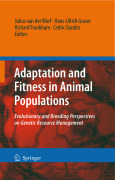
Adaptation and fitness in animal populations: evolutionary and breeding perspectives on genetic resource management
Werf, J. van der
Graser, H.
Frankham, R.
Gondro, C.
Fitness and adaptation are fundamental characteristics of plant and animal species, enabling them to survive in their environment and to adapt to the inevitable changes in this environment. This is true for both the genetic resourcesof natural ecosystems as well as those used in agricultural production. Extensive genetic variation exists between varieties/breeds in a species and amongst individuals within breeds. This variation has developed over very long periods of time. A major ongoing challenge is how to best utilize this variation tomeet short-term demands whilst also conserving it for longer-term possible use. Many animal breeding programs have led to increased performance for production traits but this has often been accompanied by reduced fitness. In addition, the global use of genetic resources prompts the question whether introduced genotypes are adapted to local production systems. A unique exchange between leading animal breeders and evolutionary geneticists Review and discussion of the key principles important to maintain fitness in breeding populations A comprehensive overview of how to explore fitness in breeding programs Strategies and approaches to manage genetic diversity Understand the value of genetic diversity to preserve fitness INDICE: From the contents Part 1: Modelling fitness; Defining fitness in natural and domesticated populations. Genetic architecture of reproductive fitness and its consequences. Fitness traits in animal breeding programs.- Part 2:Maintaining fitness. Maintaining genetic variation in fitness. Spherical cowsgrazing in flatland: constraints to selection and adaptation. Maintaining fitness by within breed selection.- Part 3: The genetic basis of adaptation. Someevolutionary consequences of niche construction. Genotype by environment interaction in farm animals. Towards new ways of directly assessing fitness in Drosophila.- Part 4: Strategies for managing diversity. Strategies to exploit genetic variation while maintaining diversity. Managing genetic diversity, fitness and adaptation of farm animal genetic resources. Livestock genetic resources: preserving genetic adaptations for future use (summary).
- ISBN: 978-1-4020-9004-2
- Editorial: Springer
- Encuadernacion: Cartoné
- Páginas: 260
- Fecha Publicación: 01/12/2008
- Nº Volúmenes: 1
- Idioma: Inglés
